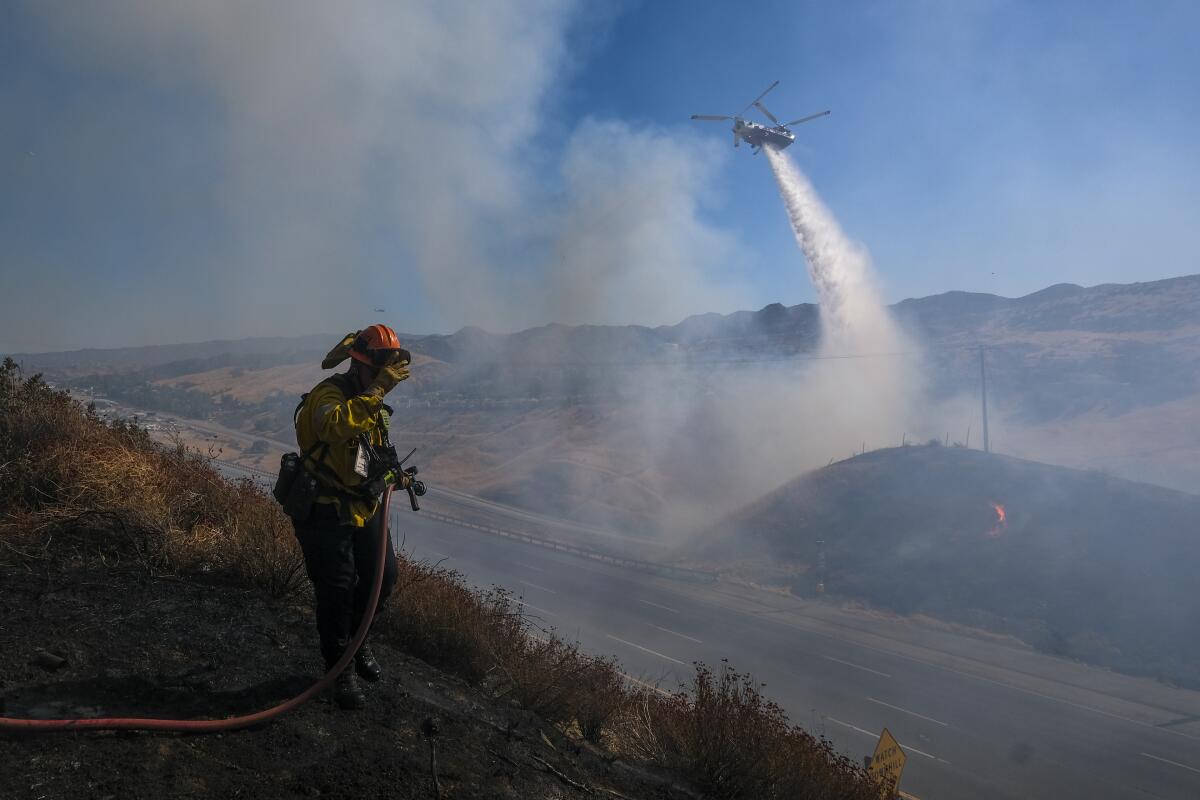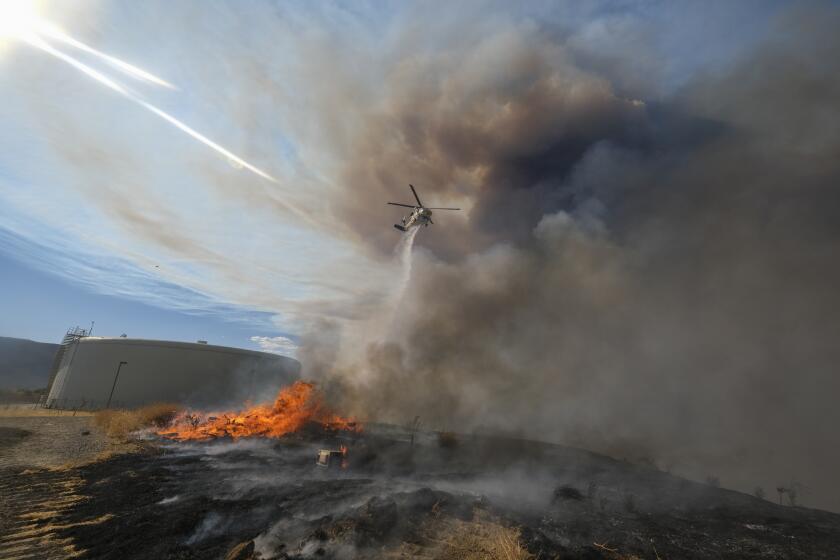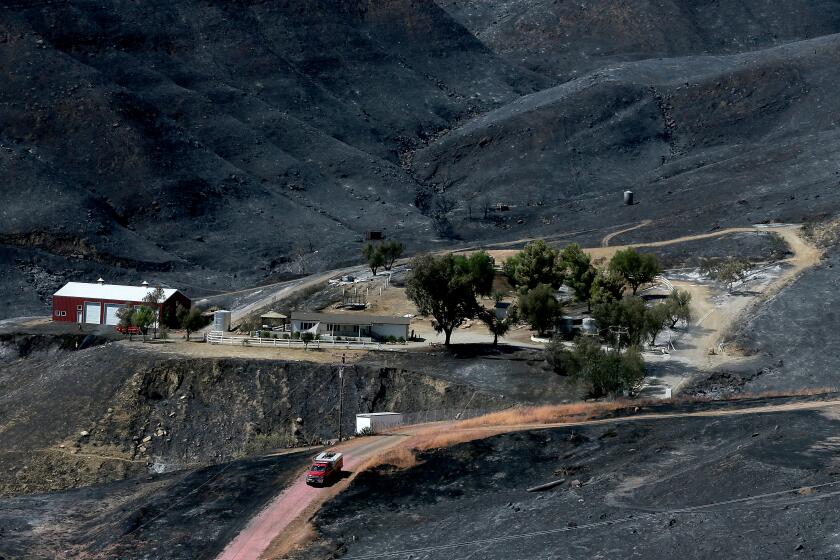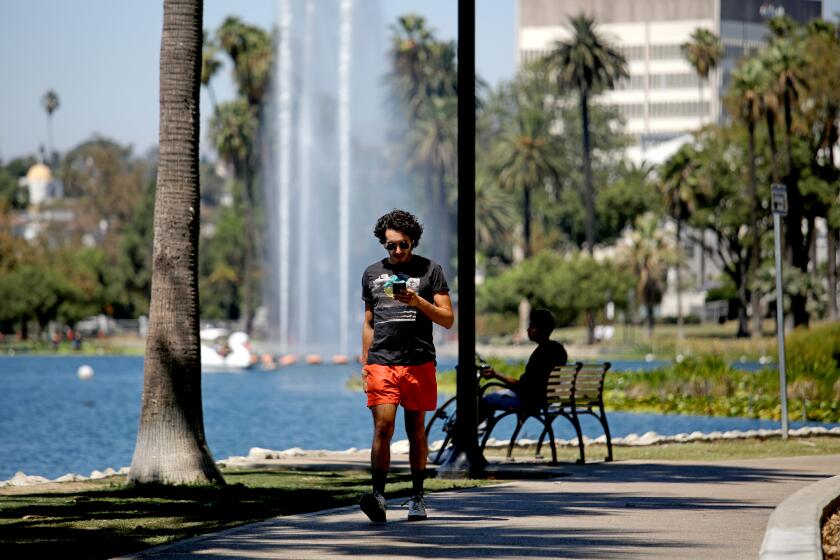Extreme heat waves are making L.A. firefighters sick, adding new dangers to job

- Share via
The first pager alert came Wednesday at 3:02 p.m.
It was 112 degrees beneath a cloudless sky, and a firefighter battling the still-nascent Route fire near Castaic was in need of medical assistance.
The next alert came five minutes later.
“It started one, then another, and then there was a page that covered two of them,” recalled Thomas Ewald, deputy fire chief with the Los Angeles County Fire Department.
By late afternoon, seven firefighters were taken to the hospital with what officials say was heat-related illness.
The illnesses — which were reported just hours after the Route fire ignited amid a punishing summer heat wave — mark a disturbing turning point in the 2022 fire season as a confluence of climate factors come to bear on California.
Experts say the combination of extreme dryness, soaring temperatures and hotter, faster wildfires is putting first responders at increasing physical risk — and the problem will likely get worse in the years to come.
California officials have extended a Flex Alert into Friday, and triple-digit heat at a fire near Castaic forced officials to pull back some firefighters on the front lines.
“To the extent that these multiple conditions coming together is chance or bad luck — there’s always an element of that when the conditions are extreme,” said Noah Diffenbaugh, a professor and senior fellow at Stanford’s Doerr School of Sustainability. “But we also have clear evidence that global warming is influencing some of the ingredients that contribute, and as a result we’re seeing very clear increases in the frequency of these conditions overall.”
Capt. Brian McGrath of the Ventura County Fire Department said heat-related illness is now a “constant concern.”
“It’s hot, it’s dry. All the normal things we deal with on a daily basis, throw on all this extra gear as well as hiking up and down the hills, holding the extra weight of a hose, being right next to the flames and the heat — it’s extremely exhausting for firefighters that are on the direct line,” said McGrath. Ventura County firefighters are also battling the Route fire.
On Thursday, conditions got so bad that officials had to issue a temporary pause on ground-based firefighting activities to prevent more heat-related injuries as the mercury soared past 110 degrees.
But research indicates that such compounding hazards are likely to increase in the years to come. A 2020 study that Diffenbaugh worked on found that the frequency of extreme weather in the autumn months has more than doubled in California the last four decades.
Evacuations have been ordered for Paradise Mobile Home Park as firefighters work to build a containment line.
Another study, published in August and led by UCLA PhD candidate Noam Rosenthal, found that the number of Californians exposed to the “multi-hazards” of heat and wildfire smoke is growing with climate change.
“Climate change is going to be increasing the intensity, the frequency and the duration of heat waves,” Rosenthal said. “It’s going to result in an increase in vapor pressure deficit — things are going to get drier — and when you have extreme dryness and extreme heat, you’re going to see an increase in fire ignition.”
During California’s record-breaking 2020 fire season, about 42% of the state’s population — roughly 16.5 million people — were exposed to a combination of extreme temperatures and high concentrations of fine particulate matter from wildfires at least once, his study found.
But he also pointed out that guidelines from the National Institute for Occupational Safety and Health underscore the emergence of an increasingly untenable situation. A person performing heavy work in 100-degree temperatures should work for 30 minutes and rest for 30 minutes, while that same worker in 104-degree temperatures should work for 20 minutes and rest for 40 minutes, the guidelines state.
At 108 degrees and above, “you basically shouldn’t be working anymore,” Rosenthal said.
“That puts us in a conundrum here,” he said. “We need to figure out how these firefighters on the frontlines can protect the public interest but also not put themselves in inordinate harm’s way.”
New study says climate change is essentially two-thirds to 88% responsible for the conditions driving wildfire woes in the western United States.
Officials at the Route fire Thursday said the injured firefighters had been released from the hospital and were recovering. But they also described working conditions that would be challenging under even the best of circumstances: Firefighters wear flame-resistant shirts, jackets and dark pants and carry heavy gear that includes their drinking water, portable fire shelters and tools such as chain saws and shovels, according to Ewald.
He said the weight varies depending on the job, but can be about 50 pounds for those carrying chain saws. Hose packs can add 25 pounds on top of personal gear.
“Add to that being in the direct sunlight, add to that that they’re kind of bundled up so a lot of the heat that would evaporate ... is trapped,” he said. “People can go from feeling pretty good to feeling pretty bad in a short period of time.”
Ewald said firefighters are supposed to drink a minimum of a gallon of water during the day and look at the clarity of their urine to gauge if they’re dehydrated. But in extreme climate conditions like those on the Route fire, problems can arise quickly.
“When’s the last time that we remember that we had above-105 temperature for seven to nine days in a row?” he asked. “That’s not something that is very common, but it’s becoming more and more common it seems like each summer. The shock value gets taken to a whole other level of weather, dryness, the lack of precipitation. ... And that’s been the story year after year.”
The triple-digit heat kicked off what forecasters warned will be a brutal weeklong stretch continuing through Labor Day weekend and into next week.
It’s not just heat that’s cause for concern — experts say California’s megadrought also plays an outsize role. The state’s hotter, drier atmosphere is sapping up moisture and leaving the landscape shriveled and dry, like tinder. Even the smallest of sparks can become an explosive blaze.
“Drier conditions, higher temperatures makes for a much more reactive fuel bed,” Ewald said. “The fires burn with more intensity, they’re more challenging to control and the work environment is that much more difficult for firefighters.”
The Route fire was the perfect example. It ignited around noon Wednesday, and by nightfall it had swelled to more than 5,000 acres in what officials described as a “rapid rate of spread.”
Diffenbaugh, of Stanford, said there have been other examples of such fast-growing fires in recent years, “but this is another marker of the conditions that we’re in now — where we’re getting these large areas burned in the 24 hours after ignition.”
“The kinds of conditions that make these extreme [fires] are the same that make it challenging to fight these fires,” he said. “It’s very hot, and it being very hot elevates the wildfire risk and also makes the physical challenge of responding to fires more acute.”
California chronically undercounts the death toll from extreme heat, which disproportionately harms the poor, the elderly and others who are vulnerable.
But while wildfires are visible and disruptive, extreme heat is also known as a “silent killer,” and is in fact one of the deadliest consequences of climate change, a Times investigation found last year.
Los Angeles County’s first Climate Vulnerability Assessment, released last fall, found that extreme heat will increase in frequency, severity and duration by mid-century — including a tenfold increase in the occurrence of heat waves. The largest increases will occur in the San Fernando and Santa Clarita valleys, not far from the Route fire.
Even the most experienced firefighters are struggling under such conditions, and forecasters have warned the current heat dome broiling the state is not expected to ease for several days.
“Yesterday was one of the days that it was hard on everybody,” Capt. Mark McCurdy of L.A. County fire station #149 in Castaic said Thursday. “I’ve done this for a little while now, and yesterday was even tough on me.”
About three hours into the assignment, McCurdy was heading up a hill when he passed one of his firefighters coming down, he recalled. The firefighter looked pale and was dizzy and told McCurdy that he wasn’t feeling well.
McCurdy sent the firefighter to the hospital, where he received fluid replacement and blood work.
“It’s what we sign up for,” McCurdy said. “But it just adds a whole other element when there’s this big of a heat wave.”
More to Read
Sign up for Essential California
The most important California stories and recommendations in your inbox every morning.
You may occasionally receive promotional content from the Los Angeles Times.




















